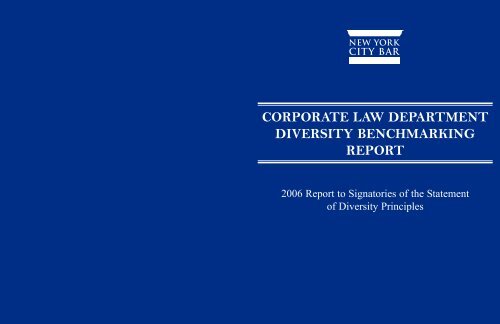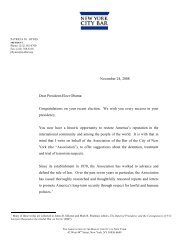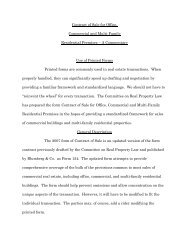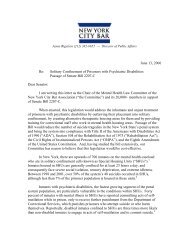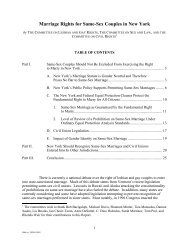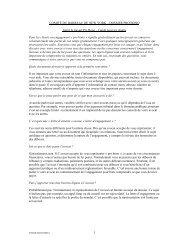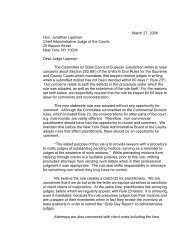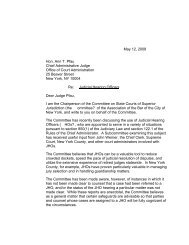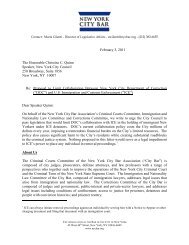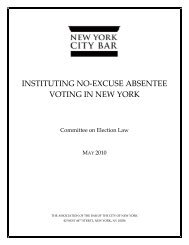2006 Corporate Law Department Diversity Benchmarking Report
2006 Corporate Law Department Diversity Benchmarking Report
2006 Corporate Law Department Diversity Benchmarking Report
You also want an ePaper? Increase the reach of your titles
YUMPU automatically turns print PDFs into web optimized ePapers that Google loves.
CORPORATE LAW DEPARTMENT<br />
DIVERSITY BENCHMARKING<br />
REPORT<br />
<strong>2006</strong> <strong>Report</strong> to Signatories of the Statement<br />
of <strong>Diversity</strong> Principles
<strong>2006</strong> <strong>Diversity</strong> <strong>Benchmarking</strong> Study:<br />
A <strong>Report</strong> to Signatory<br />
<strong>Corporate</strong> <strong>Law</strong> <strong>Department</strong>s<br />
Sponsored by:<br />
Deloitte<br />
UBS<br />
© <strong>2006</strong> by the New York City Bar Association<br />
For further information, please contact:<br />
Meredith Moore, Director of the Office for <strong>Diversity</strong>,<br />
at 212-382-6689 or mmoore@nycbar.org.<br />
The New York City Bar Association<br />
42 West 44 th Street, New York, NY 10036<br />
www.nycbar.org
<strong>2006</strong> <strong>Corporate</strong> <strong>Law</strong> <strong>Department</strong> <strong>Diversity</strong> <strong>Benchmarking</strong> <strong>Report</strong><br />
TABLE OF CONTENTS<br />
1) Introduction (3)<br />
2) Executive Summary (4)<br />
3) Representation and Hiring By Level (6)<br />
4) National Comparisons (13)<br />
5) Flexible Work Arrangements (14)<br />
6) Racial/Ethnic Minorities (16)<br />
7) Gender (21)<br />
8) Openly Gay Attorneys (23)<br />
9) Attorneys with Disabilities (23)<br />
10) <strong>Law</strong> Firm Comparisons (25)<br />
11) Conclusion (28)<br />
12) Recommendations—Analyzing <strong>Law</strong> <strong>Department</strong> Data (29)<br />
13) Acknowledgements (31)<br />
Contributors to the Office for <strong>Diversity</strong><br />
Enhance <strong>Diversity</strong> in the Profession Committee<br />
Signatories to the Statement of <strong>Diversity</strong> Principles<br />
© New York City Bar Association, <strong>2006</strong> 2
<strong>2006</strong> <strong>Corporate</strong> <strong>Law</strong> <strong>Department</strong> <strong>Diversity</strong> <strong>Benchmarking</strong> <strong>Report</strong><br />
PURPOSE<br />
This is the first New York City Bar corporate law department diversity<br />
benchmarking report. As Signatories to the Association’s Statement of <strong>Diversity</strong><br />
Principles, these law departments have committed to monitor improvement on<br />
key diversity metrics over time. This study is the first of its kind to look at the<br />
composition of in-house legal departments by level, as well as examining flexible<br />
work arrangements and new hires. The benchmarking report is a powerful tool<br />
for law departments to focus their diversity efforts by identifying where they are<br />
doing well and where they are lagging behind.<br />
It is important to note that, due to the small number of corporate law department<br />
signatories, this data should not be considered representative of all law<br />
departments in New York City much less nationwide. Furthermore, in<br />
comparison to the few national benchmarks available, the corporate signatories<br />
tend to have better diversity representation at the top than the national average.<br />
METHODOLOGY<br />
This data is based on the responses of 15 corporate law department<br />
signatories to the New York City Bar’s Statement of <strong>Diversity</strong> Principles, as of<br />
March <strong>2006</strong>. This represents an 83 percent response rate.<br />
Of the 17 signatories at the time of the study, 11 are in the Fortune 100, 3 are<br />
Fortune 101-500, 2 are professional firms, and 1 is based outside of the US.<br />
Signatories hail across the Greater Metropolitan New York area: 13 have US<br />
headquarters in New York, 1 in Connecticut, and 3 in New Jersey.<br />
Each individual law department’s response to the web-based survey is<br />
treated as anonymous and confidential.<br />
This data is a snapshot of participating law departments as of January <strong>2006</strong>.<br />
This data represents only the greater metropolitan New York City area offices<br />
of the signatory law departments.<br />
For comparison purposes, we utilized the demographic categories and<br />
terminology employed by the National Association of <strong>Law</strong> Placement (NALP),<br />
collecting data on Women, Men, American Indian, Asian-American/Pacific-<br />
Islanders, Black, Hispanic, Multi-racial, Openly Gay, and Disabilities.<br />
We also collected data on the intersections of race and gender enabling us to<br />
compare white men, white women, men of color, and women of color.<br />
We gathered data by level on the current composition of the law departments,<br />
formal full-time and part-time flexible work arrangements, and new hires.<br />
Levels<br />
To collect comparable data across corporations with varying law department<br />
structures, we requested data for 4 levels with representative titles given.<br />
Level 1: General Counsel (GC), Chief Legal Officer (CLO)<br />
Level 2: Deputy GC/CLO, Division or Practice Head, Direct <strong>Report</strong>s to GC/CLO<br />
Level 3: Managing Attorneys, High Level Specialists<br />
Level 4 and Below: All Other Attorneys<br />
© New York City Bar Association, <strong>2006</strong> 3
<strong>2006</strong> <strong>Corporate</strong> <strong>Law</strong> <strong>Department</strong> <strong>Diversity</strong> <strong>Benchmarking</strong> <strong>Report</strong><br />
EXECUTIVE SUMMARY<br />
Overall, signatory law departments are diverse with respect to race and<br />
gender. Compared to the legal profession as a whole, the legal departments of<br />
signatory corporations boast considerable diversity. Fifteen percent of in-house<br />
lawyers are racial/ethnic minorities and 44 percent are women. Much lower<br />
percentages of attorneys are characterized as openly gay or attorneys with<br />
disabilities, which is more likely due to lack of data collection than the absence of<br />
this type of diversity in these law departments.<br />
Overal <strong>Diversity</strong> in Signatory <strong>Law</strong> <strong>Department</strong>s (1,216) as of<br />
January <strong>2006</strong><br />
44.2%<br />
15.5%<br />
0.6% 0.0%<br />
Minorities Women Openly Gay Attorneys with Disabilities<br />
Compared to law firm signatories, corporate law departments are faring better<br />
with women overall (35.5%) and at all levels. <strong>Corporate</strong> signatories are keeping<br />
pace with firms overall with minorities (15.1%) but exceed firms at the upper tiers.<br />
However, firm signatories are leading the way with respect to counting their<br />
openly gay attorneys and attorneys with disabilities (2.3%, 0.1%).<br />
There is more diversity in the lower levels of signatory law departments<br />
than in the upper tiers. Approximately one-fifth of the 4 th level, or junior-most<br />
attorneys, in signatory law departments are racial/ethnic minorities. The<br />
proportion drops to 11 percent for level 3 (managing attorneys) and 9.5 percent<br />
for level 2 (Deputy General Counsels). There is an upswing with nearly one-fifth<br />
of signatory general counsel positions occupied by racial/ethnic minorities. In<br />
other words, three of the sixteen general counsels are minorities.<br />
Racial/Ethnic Minorities By Level (1,216) as of January <strong>2006</strong><br />
19.7%<br />
18.8%<br />
11.0%<br />
9.5%<br />
Level 4 Level 3 Level 2 Level 1<br />
Over one-half of the bottom rung of signatory law departments are comprised of<br />
women, dropping to 41.5 percent at the next level. Women represent onequarter<br />
of the top two tiers in the law departments. There are 4 women general<br />
counsels out of 16 total positions in signatory corporations.<br />
© New York City Bar Association, <strong>2006</strong> 4
<strong>2006</strong> <strong>Corporate</strong> <strong>Law</strong> <strong>Department</strong> <strong>Diversity</strong> <strong>Benchmarking</strong> <strong>Report</strong><br />
Women By Level (1,216) as of January <strong>2006</strong><br />
50.6%<br />
41.5%<br />
24.8% 25.0%<br />
Level 4 Level 3 Level 2 Level 1<br />
Only three signatory corporations provided data on their openly gay attorneys,<br />
and no companies reported attorneys with disabilities. We urge employers to<br />
seek a more complete and accurate picture of the diversity in their organization<br />
by sending a confidential and anonymous questionnaire that solicits an accurate<br />
count of all demographic categories.<br />
The racial and gender diversity of General Counsels in signatory<br />
corporations surpasses the Fortune 500. Compared to the Fortune 500<br />
where 6.4 percent of General Counsels are minorities (32), the NYC Bar<br />
signatories are ahead of the curve with triple the percentage in the top job, 18.8<br />
percent (3) 1 . With one-quarter of general counsel titles in signatory law<br />
departments held by women (4), the signatories outperform the F500 where 15<br />
percent of general counsels (76) are women 2 .<br />
Conclusion. The small numbers of corporate signatories and their gender and<br />
racial diversity at the general counsel level mean there are limits to extrapolating<br />
to other New York City companies, much less across the nation. This study<br />
provides a baseline for the corporate signatories to the New York City Bar’s<br />
Statement of <strong>Diversity</strong> Principles to measure their progress overtime. The<br />
greater diversity of the senior leadership of these law departments compared to<br />
the Fortune 500 would suggest that their numbers at all levels might also surpass<br />
other corporations. That said, even these corporations have room for<br />
improvement in certain areas, such as collecting data on a wider spectrum of<br />
demographic categories and bolstering the diversity of the steppingstones to the<br />
general counsel position.<br />
1 MCCA, “Survey of Fortune 500 Minority General Counsel,” <strong>2006</strong>.<br />
2 MCCA, “Survey of Fortune 500 Women General Counsel,” <strong>2006</strong>.<br />
© New York City Bar Association, <strong>2006</strong> 5
<strong>2006</strong> <strong>Corporate</strong> <strong>Law</strong> <strong>Department</strong> <strong>Diversity</strong> <strong>Benchmarking</strong> <strong>Report</strong><br />
FULL REPORT<br />
ENTRY LEVEL—LEVEL 4<br />
Representation. The entry level, or level 4, boasts the most diversity in<br />
signatory law departments. Nearly one-fifth of the junior-most attorneys are<br />
racial/ethnic minorities 3 and one-half are women. Only 2 attorneys (0.3%) are<br />
counted as openly gay and none are listed as attorneys with disabilities.<br />
Total Level 4 (634) in <strong>Diversity</strong> Signatory <strong>Law</strong> <strong>Department</strong>s, as of<br />
January <strong>2006</strong><br />
80.3%<br />
49.4% 50.6%<br />
19.7%<br />
0.3% 0.0%<br />
Minorities Whites Men Women Openly Gay Disabled<br />
Examining race and gender together, white men are the largest demographic<br />
group (43%) represented in the entry level of signatory corporate law<br />
departments. White women follow with over one-third of junior attorneys. The<br />
percentage of women of color in level four is over twice that of men of color<br />
(13%, 6%).<br />
Race and Gender of Level 4 (634), as of January <strong>2006</strong><br />
43.1%<br />
6.3%<br />
13.4%<br />
37.2%<br />
Men of Color<br />
Women of Color<br />
White Women<br />
White Men<br />
3 For data by specific racial/ethnic group, refer to the Racial/Ethnic Minority section later in this<br />
publication.<br />
© New York City Bar Association, <strong>2006</strong> 6
<strong>2006</strong> <strong>Corporate</strong> <strong>Law</strong> <strong>Department</strong> <strong>Diversity</strong> <strong>Benchmarking</strong> <strong>Report</strong><br />
Level 4 New Hires. There is greater gender and racial diversity in the new hires<br />
compared to their overall presence in the ranks of junior attorneys in corporate<br />
law department signatories. Racial/ethnic minorities comprise one-quarter and<br />
women three-fifths of new hires over the course of 2005. None of the new hires<br />
are categorized as openly gay or attorneys with disabilities.<br />
Level 4 Hiring (127) in <strong>Diversity</strong> Signatory <strong>Law</strong> <strong>Department</strong>s, as of<br />
January-December 2005<br />
75.6%<br />
61.4%<br />
24.4%<br />
38.6%<br />
0.0% 0.0%<br />
Minorities Whites Men Women Openly Gay Disabled<br />
Breaking the data down further, over two-fifths of newly hired junior in-house<br />
attorneys are white women, one-third are white men, nearly one in ten are<br />
women of color, and only six percent are men of color. The overall ratio of white<br />
men to white women is reversed for new hires with more white women than white<br />
men among the incoming junior attorneys. The discrepancy between women and<br />
men of color widens among new hires in level four.<br />
Race and Gender of Level 4 New Hires,<br />
January - December 2005<br />
5.5%<br />
33.1%<br />
18.9%<br />
Men of Color<br />
Women of Color<br />
White Women<br />
White Men<br />
42.5%<br />
Most corporate law departments do not hire attorneys immediately upon law<br />
school graduation. According to NALP data on initial employer types, 12.5<br />
percent of men and 10.0 percent of women first went to business/industry upon<br />
graduating from law school in 2004, with little change from 1982 and 1994<br />
comparisons 4 . The higher percentage of women as new hires likely reflects the<br />
higher turnover of women mid-level associates (42%) in signatory law firms<br />
compared to their male counterparts (31%). This is particularly pronounced for<br />
women of color where 44 percent of women of color mid-level associates depart<br />
signatory firms.<br />
4 NALP, “Employment Patterns — 1982-2004”, <strong>2006</strong>.<br />
© New York City Bar Association, <strong>2006</strong> 7
<strong>2006</strong> <strong>Corporate</strong> <strong>Law</strong> <strong>Department</strong> <strong>Diversity</strong> <strong>Benchmarking</strong> <strong>Report</strong><br />
MANAGING ATTORNEYS & HIGH LEVEL SPECIALISTS—LEVEL 3<br />
Representation. The next rung up the corporate law department ladder, or level<br />
3, has declining racial and gender diversity. Over one-tenth of managing<br />
attorneys are racial/ethnic minorities and four-in-ten are women. Less than onepercent<br />
are reported as openly gay and none are attorneys with disabilities at this<br />
level.<br />
Total Level 3 (429) in <strong>Diversity</strong> Signatory <strong>Law</strong> <strong>Department</strong>s, as of<br />
January <strong>2006</strong><br />
89.0%<br />
58.5%<br />
41.5%<br />
11.0%<br />
0.9% 0.0%<br />
Minorities Whites Men Women Openly Gay Disabled<br />
Looking at the data by race and gender, over one-half of managing attorneys are<br />
white men and one-third are white women furthering the gender divide seen in<br />
level 4. Percentage-wise, there are twice as many women of color (8%) as men<br />
of color (4%) at this level. While the drop in racial/ethnic minorities is noticeable<br />
from level 4 to 3 overall, it is most pronounced for women of color declining from<br />
13 percent to 8 percent.<br />
Race and Gender of Level 3 (429), As of January <strong>2006</strong><br />
4.4%<br />
54.1%<br />
8.4%<br />
33.1%<br />
Men of Color<br />
Women of Color<br />
White Women<br />
White Men<br />
© New York City Bar Association, <strong>2006</strong> 8
<strong>2006</strong> <strong>Corporate</strong> <strong>Law</strong> <strong>Department</strong> <strong>Diversity</strong> <strong>Benchmarking</strong> <strong>Report</strong><br />
Level 3 New Hires. Nearly one-tenth of managing attorneys hired in 2005 are<br />
racial/ethnic minorities and less than one-half are women. None of the signatories<br />
report having hired openly gay or attorneys with disabilities at this level.<br />
Level 3 Hiring (43) in <strong>Diversity</strong> Signatory <strong>Law</strong> <strong>Department</strong>s,<br />
January-December 2005<br />
90.7%<br />
51.2% 48.8%<br />
9.3%<br />
0.0% 0.0%<br />
Minorities Whites Men Women Openly Gay Disabled<br />
While white women surpassed white men in level 4 new hires, the ratio is<br />
reversed in level three with white men comprising over two-fifths and white<br />
women one-third of newly hired managing attorneys. The representation of<br />
men—both white men and men of color—is greater in level 3 rather than level 4<br />
hires. Men and women of color represent nearly twice the proportion of new<br />
hires at level 3 than their representation of managing attorneys overall. If this<br />
trend continues, this may bolster the racial diversity at the managing attorney<br />
level. We did not collect data on promotions, so we cannot determine the<br />
demographics of those internally promoted from level 4 as opposed to being<br />
hired externally.<br />
Race and Gender of Level 3 New Hires,<br />
January - December 2005<br />
9.3%<br />
41.9%<br />
16.3%<br />
32.6%<br />
Men of Color<br />
Women of Color<br />
White Women<br />
White Men<br />
© New York City Bar Association, <strong>2006</strong> 9
<strong>2006</strong> <strong>Corporate</strong> <strong>Law</strong> <strong>Department</strong> <strong>Diversity</strong> <strong>Benchmarking</strong> <strong>Report</strong><br />
DEPUTY GENERAL COUNSELS, DIVISION/PRACTICE HEADS—LEVEL 2<br />
Representation. The direct reports to the general counsel, or level 2, in<br />
signatory law departments decline further in representation of women but hold<br />
relatively steady for minorities. Nearly one-tenth of division heads are<br />
racial/ethnic minorities and one-quarter are women. Less than one-percent are<br />
reported as openly gay and none are attorneys with disabilities at this level.<br />
Total Level 2 (137) in <strong>Diversity</strong> Signatory <strong>Law</strong> <strong>Department</strong>s, as of<br />
January <strong>2006</strong><br />
90.5%<br />
75.2%<br />
9.5%<br />
24.8%<br />
0.7% 0.0%<br />
Minorities Whites Men Women Openly Gay Disabled<br />
Looking at the data by race and gender, two-thirds of division/practice heads are<br />
white men and over two-tenths are white women widening the gender gap<br />
present at the previous two levels. Furthermore, the trend in the previous two<br />
levels where women of color outnumber men of color reverses itself with 6<br />
percent men of color and 4 percent women of color at level 2.<br />
Race and Gender of Level 2 (137), As of January <strong>2006</strong><br />
69.3%<br />
5.8%<br />
3.7%<br />
21.2%<br />
Men of Color<br />
Women of Color<br />
White Women<br />
White Men<br />
The division heads can be considered an important source of future general<br />
counsel talent, either from an internal promotion or external hires. Future studies<br />
may explore internal promotions in corporate law departments.<br />
© New York City Bar Association, <strong>2006</strong> 10
<strong>2006</strong> <strong>Corporate</strong> <strong>Law</strong> <strong>Department</strong> <strong>Diversity</strong> <strong>Benchmarking</strong> <strong>Report</strong><br />
Level 2 New Hires. Ten new deputy counsels joined the ranks of signatory law<br />
departments (nearly one-quarter of the overall 43 in level 2). Seven of the new<br />
practice/division heads are white and 7 are men.<br />
Level 2 Hiring (10) in <strong>Diversity</strong> Signatory <strong>Law</strong> <strong>Department</strong>s,<br />
January-December 2005<br />
70.0% 70.0%<br />
30.0%<br />
30.0%<br />
0.0% 0.0%<br />
Minorities Whites Men Women Openly Gay Disabled<br />
Looking at the data by race and gender, 5 of the level 2 new hires are white men,<br />
2 each are white women and men of color, and 1 is a woman of color. While the<br />
overall numbers of new hires at this level are small, the proportions of women<br />
and men of color exceed their overall presence among deputy general counsels.<br />
If maintained, this could bode well for bolstering the pipeline for minority and<br />
women general counsels in signatory companies.<br />
Race and Gender of Level 2 New Hires,<br />
January - December 2005<br />
50.0%<br />
20.0%<br />
10.0%<br />
20.0%<br />
Men of Color<br />
Women of Color<br />
White Women<br />
White Men<br />
© New York City Bar Association, <strong>2006</strong> 11
<strong>2006</strong> <strong>Corporate</strong> <strong>Law</strong> <strong>Department</strong> <strong>Diversity</strong> <strong>Benchmarking</strong> <strong>Report</strong><br />
GENERAL COUNSELS—LEVEL 1<br />
Representation. The majority of general counsels in signatory law departments<br />
are white (81%) and men (75%). Of the 16 general counsels, four are women<br />
and 3 are racial/ethnic minorities. None are considered openly gay or attorneys<br />
with disabilities.<br />
General Counsels (16) in Signatory <strong>Law</strong> <strong>Department</strong>s, as of January<br />
<strong>2006</strong><br />
81.3%<br />
75.0%<br />
18.8%<br />
25.0%<br />
0.0% 0.0%<br />
Minorities White Men Women Openly Gay Disabled<br />
Examining race and gender together, over one-half of general counsels at<br />
corporate signatories are white men, one-quarter are white women, nearly onetenth<br />
are men of color, and none are women of color. This further reinforces the<br />
trend where women of color outnumber men of color at the bottom of law<br />
departments, but men of color surpass women of color at the upper echelons.<br />
Race and Gender of General Counsels, As of January <strong>2006</strong><br />
56.3%<br />
18.8%<br />
0.0%<br />
25.0%<br />
Men of Color<br />
Women of Color<br />
White Women<br />
White Men<br />
Level 1 New Hires. There was only one new general counsel hired externally at<br />
signatory companies (a white man) during the 2005 calendar year. We do not<br />
know if any internal promotions occurred during this time period.<br />
According to the MCCA, public sector and litigation experience are increasingly<br />
important prerequisites for general counsels, particularly for minorities 5 . Four in<br />
ten of the minority Fortune 500 general counsels in <strong>2006</strong> have public sector<br />
experience, compared to over one-quarter of white general counsels 6 . Nearly<br />
three-quarters of the minority general counsels have law firm experience.<br />
5 “Become a General Counsel: The New Track to the Top,” <strong>Diversity</strong> & The Bar, Sept./Oct. 2005.<br />
6 MCCA, “Survey of Fortune 500 Minority General Counsel,” <strong>2006</strong>.<br />
© New York City Bar Association, <strong>2006</strong> 12
<strong>2006</strong> <strong>Corporate</strong> <strong>Law</strong> <strong>Department</strong> <strong>Diversity</strong> <strong>Benchmarking</strong> <strong>Report</strong><br />
NATIONAL COMPARISONS<br />
Compared to the Fortune 500 where 6.4 percent of General Counsels are<br />
minorities (32), the NYC Bar signatories are ahead of the curve with triple the<br />
percentage in the top job at 18.8 percent (3) 7 . With one-quarter of general<br />
counsel titles in signatory law departments held by women (4), the signatories<br />
outperform the F500 where 15 percent of general counsels (76) are women 8 .<br />
Comparison of General Counsels in NYC Bar Signatories<br />
and Fortune 500 (Source: MCCA, <strong>2006</strong>)<br />
25.0%<br />
18.8%<br />
6.4%<br />
15.0%<br />
NYC Bar Signatories<br />
Fortune 500<br />
Minorities<br />
Women<br />
There is limited recent comparative data by level. According to the Association<br />
of <strong>Corporate</strong> Counsel, 12.5 percent of in-house counsels are racial/ethnic<br />
minorities in 2001 compared to 9.0 percent in 1998 9 . They collected data for 7<br />
titles, as opposed to the 4 levels collected in this study. Direct comparisons<br />
about levels and titles are difficult, but we loosely bundled some of their titles to<br />
correspond with our data. Assuming time will improve the ACC numbers<br />
somewhat, it could be argued that our signatories are still probably faring better<br />
for minorities and are tracking closely for women at most levels.<br />
Level<br />
ACCA 2001 Study NYC Bar <strong>2006</strong><br />
Minorities Women Minorities Women<br />
Level 1<br />
General Counsels 9.1% 21.8% 18.8% 25.0%<br />
Level 2<br />
Deputy General 2.7% 21.0%<br />
Counsel<br />
9.5% 24.8%<br />
Division Counsel 7.6% 31.6%<br />
Level 3<br />
Managing Attorneys 0.5% 80.8%<br />
Assistant General 26.2% 29.9% 11.0% 41.5%<br />
Counsels<br />
Level 4<br />
Senior Attorneys 12.0% 34.2% 19.7% 50.6%<br />
Staff Attorneys 16.4% 48.8%<br />
7 MCCA, “Survey of Fortune 500 Minority General Counsel,” <strong>2006</strong>.<br />
8 MCCA, “Survey of Fortune 500 Women General Counsel,” <strong>2006</strong>.<br />
9 Association of <strong>Corporate</strong> Counsel, ACC 2001 Census of Inhouse Counsel, 2004.<br />
© New York City Bar Association, <strong>2006</strong> 13
<strong>2006</strong> <strong>Corporate</strong> <strong>Law</strong> <strong>Department</strong> <strong>Diversity</strong> <strong>Benchmarking</strong> <strong>Report</strong><br />
FLEXIBLE WORK ARRANGEMENTS<br />
Overall, signatory law departments report that 51 attorneys, or 4.2 percent, work<br />
flexibly 10 in New York law offices. The majority of those on flexible work<br />
arrangements in corporate signatories have full-time FWAs (3.2%) as opposed to<br />
part-time arrangements (1.0%). This study does not attempt to count informal<br />
flexibility, where an individual may work at home on an occasional basis.<br />
According to hiring data provided by corporate signatories, none of their new<br />
hires at any level in 2005 were brought in on a formal flexible work arrangement.<br />
By Gender. As a whole, women in signatory law departments are more likely to<br />
avail themselves of flexible work arrangements than their male counterparts.<br />
Nearly 8 percent of women in-house attorneys work flexibly (full and part time)<br />
compared to just over one percent of men. There are no men reported to be<br />
working on a part-time schedule compared to 2.2 percent of women. Looking at<br />
full-time flexible schedules, such as telecommuting, 5.6 percent of in-house<br />
women and 1.3 percent of men work on full-time FWAs.<br />
Formal Flexible Work Arrangements by Level and Gender, as of January <strong>2006</strong><br />
Gender Level Total<br />
Flexibility (Full<br />
& Part-time)<br />
Part-time<br />
Flexibility<br />
Percent<br />
Total<br />
Flexibility<br />
Women<br />
Men<br />
Percent<br />
Part-time<br />
Flexibility<br />
Level 1 0 0 0% 0%<br />
Level 2 3 2 8.8% 2.9%<br />
Level 3 21 2 11.8% 1.1%<br />
Level 4 18 8 5.6% 2.5%<br />
Total 42 12 7.8% 2.2%<br />
Level 1 0 0 0% 0%<br />
Level 2 2 0 1.9% 0%<br />
Level 3 3 0 1.2% 0%<br />
Level 4 4 0 1.3% 0%<br />
Total 9 0 1.3% 0%<br />
Put another way, women comprise 82.4 percent of all in-house lawyers working<br />
flexibly. Furthermore, women represent 100 percent of part-time arrangements<br />
at corporate signatories. While the overall proportion of women working flexibly is<br />
similar with law firms (85%), men in law firms represent a greater proportion of<br />
attorneys with reduced work arrangements (16%) than men in-house (0%).<br />
10 Generally speaking, full-time flexible work arrangements (FWAs) are defined as alternative<br />
arrangements for full-time work that vary the timing or location of work (e.g., flex-time and<br />
telecommuting.) Part-time, or reduced schedule, FWAs involve fewer hours than what would be<br />
considered full time.<br />
© New York City Bar Association, <strong>2006</strong> 14
<strong>2006</strong> <strong>Corporate</strong> <strong>Law</strong> <strong>Department</strong> <strong>Diversity</strong> <strong>Benchmarking</strong> <strong>Report</strong><br />
By Gender and Level. Not surprisingly, none of the general counsels of either<br />
gender have a flexible work arrangement. Full-time flexible work arrangements<br />
are proportionately most common for women and men at level 2 (deputy general<br />
counsel). This may be due in part to the ability to control one’s schedule at that<br />
level enabling, for example, the ability to work at home regularly one day per<br />
week. Role models in senior roles—both women and men—are essential to<br />
counter the perception that flexibility is an impediment to advancement and that it<br />
is just a women’s issue.<br />
The largest percentage of women working flexibly (full and part time) is at level<br />
three (11.8%), although proportionately fewer are working reduced work<br />
schedules (1.1%). At level 4, 5.6 percent of women and 1.3 percent of men are<br />
working flexibly, with 2.5 percent of women on reduced work arrangements.<br />
By Race and Gender. White women are the most frequent users of flexibility<br />
across groups with white men the least likely to have formal flexible schedules.<br />
These differences vary by level with no minorities working flexibly at level two<br />
where the highest percentage of white men utilize full-time FWAs. In level 3,<br />
minority women surpass white women in their usage of full-time flexibility. At the<br />
bottom level, white women have the highest percentage with FWAs followed by<br />
minority men. All of the reduced hour arrangements reported by corporate<br />
signatories are held by white women.<br />
Formal Flexible Work Arrangements (Full- and Part-time)<br />
by Level, Race/Ethnicity and Gender, as of January <strong>2006</strong><br />
Level<br />
White Minority Minority White Men<br />
Women Women Men<br />
Level 1 0% N/A 0% 0%<br />
Level 2 10.3% 0% 0% 2.1%<br />
Level 3 10.6% 16.7% 10.5% 0.4%<br />
Level 4 7.2% 1.2% 2.5% 1.1%<br />
Total 8.5% 5.6% 4.3% 1.0%<br />
<strong>Law</strong> Firm Comparison. Essentially the same percentage of attorneys in<br />
corporate law departments work flexibly compared to law firm signatories (4.2%,<br />
4.0%). The majority of in-house lawyers working flexibly have full-time formal<br />
FWAs, while in law firms most FWAS are reduced work arrangements. This may<br />
be due to more comfort around telecommuting in corporations than firms.<br />
In Catalyst’s study on women in law, the number one reason women chose to<br />
work in a corporate law department was due to work/life balance. However,<br />
fewer women in-house than women in firms believed they could use FWAs<br />
without affecting career advancement (22%, 9%) 11 .<br />
11 Catalyst, Women in <strong>Law</strong>: Making the Case, 2001.<br />
© New York City Bar Association, <strong>2006</strong> 15
<strong>2006</strong> <strong>Corporate</strong> <strong>Law</strong> <strong>Department</strong> <strong>Diversity</strong> <strong>Benchmarking</strong> <strong>Report</strong><br />
RACIAL/ETHNIC MINORITIES<br />
Overall, the percentage of minorities in signatory law departments is similar at<br />
the bottom and top rung, but drops at mid-levels 2 and 3. Approximately one-fifth<br />
of the 4 th level, or junior-most attorneys, in signatory law departments are<br />
racial/ethnic minorities. The proportion drops to 11 percent for level 3 (managing<br />
attorneys) and 9.5 percent for level 2 (Deputy General Counsels). There is an<br />
upswing with nearly one-fifth of signatory general counsel positions occupied by<br />
racial/ethnic minorities. In other words, three of the sixteen general counsels are<br />
minorities.<br />
Racial/Ethnic Minorities By Level (1,216) as of January <strong>2006</strong><br />
19.7%<br />
18.8%<br />
11.0%<br />
9.5%<br />
Level 4 Level 3 Level 2 Level 1<br />
.<br />
Examining signatory corporate law departments by racial group, African-<br />
Americans follow Caucasian attorneys as the second most highly represented<br />
group. The next most prevalent groups are Asian-Americans followed by<br />
Hispanic attorneys. There are 3 American Indian/Alaskan attorneys, or less than<br />
one-tenth of a percent of in-house attorneys. Signatory companies report having<br />
no multi-racial attorneys.<br />
Total Attorneys by Race/Ethnicity in Signatory <strong>Corporate</strong> <strong>Law</strong><br />
<strong>Department</strong>s, As of January <strong>2006</strong><br />
6.0%<br />
7.1%<br />
0.0%<br />
2.2%<br />
0.0%<br />
Am. Ind/Alsk. As. & Pac. Isl. Black Hispanic Multi-racial<br />
African-American Attorneys. All three minority general counsels in signatory<br />
companies are African-Americans. With such a small number of signatory<br />
companies, there are twice as many African-American attorneys in the general<br />
counsel ranks than are at the bottom-rung. African-Americans occupy only three<br />
percent of the departmental and division leadership in signatory law departments.<br />
In addition, there are proportionately twice as many African-Americans in<br />
signatory companies than firms (3.4%).<br />
© New York City Bar Association, <strong>2006</strong> 16
<strong>2006</strong> <strong>Corporate</strong> <strong>Law</strong> <strong>Department</strong> <strong>Diversity</strong> <strong>Benchmarking</strong> <strong>Report</strong><br />
Black/African-Americans By Level as of January <strong>2006</strong><br />
18.8%<br />
7.9%<br />
6.8%<br />
2.9%<br />
Level 4 Level 3 Level 2 Level 1<br />
Ten percent of new hires of junior attorneys and 7 percent of managing attorneys<br />
are African-Americans. <strong>Corporate</strong> law departments are probably benefiting from<br />
the high levels of attrition among African-American associates at signatory law<br />
firms, particularly among mid-level associates. None of the newly hired attorneys<br />
at the top levels are African-American.<br />
Asian-American/Pacific-Islander Attorneys. Overall, while there are more<br />
African-Americans than Asian-Americans in signatory corporations, Asian-<br />
Americans are the most prevalent among junior attorneys of color. The<br />
percentage drops off considerably at the next level of managing attorneys where<br />
there are half as many Asian-American attorneys as African-American. Among<br />
deputy general counsel, the percentage rises to 4 percent where Asian-<br />
Americans are the largest minority group.<br />
Asian-Americans/Pacific Islanders By Level as of January <strong>2006</strong><br />
8.7%<br />
2.8%<br />
4.4%<br />
0.0%<br />
Level 4 Level 3 Level 2 Level 1<br />
In signatory law firms, there are nearly twice as many Asian-American attorneys<br />
as African-American and Hispanic attorneys. Asian-Americans have the highest<br />
turnover among junior associates in signatory firms, which may help explain why<br />
Asian-Americans have the highest percentage of junior attorney recruits (11%) in<br />
corporate law departments. There are no Asian-Americans among the level 3<br />
new hires, but they comprised 20 percent of recently hired deputy general<br />
counsels.<br />
© New York City Bar Association, <strong>2006</strong> 17
<strong>2006</strong> <strong>Corporate</strong> <strong>Law</strong> <strong>Department</strong> <strong>Diversity</strong> <strong>Benchmarking</strong> <strong>Report</strong><br />
Hispanic Attorneys. Of racial/ethnic minorities in signatory companies,<br />
Hispanics trail African- and Asian-Americans at all levels. Comparing the lowest<br />
levels of signatory companies and firms, 2.8 percent of junior in-house attorneys<br />
are Hispanics, compared to 3.9 percent of associates in signatory firms. The<br />
percentage of Hispanic in-house attorneys declines among managing attorneys,<br />
and then increases somewhat for deputy general counsels.<br />
Hispanics By Level as of January <strong>2006</strong><br />
2.8%<br />
2.2%<br />
1.4%<br />
0.0%<br />
Level 4 Level 3 Level 2 Level 1<br />
The percentage of Hispanic new hires somewhat exceeds their representation at<br />
the bottom two levels (3.2% level 4, 2.3% level 3.) Ten percent of new deputy<br />
general counsels are Hispanic (1 of 10.)<br />
Entry Level—Level 4. Asian-American attorneys have the highest percentage<br />
of junior attorneys of color, followed by African-Americans. The only American<br />
Indian attorneys present in signatory corporations are in level four.<br />
Level 4 by Race/Ethnicity in Signatory <strong>Corporate</strong> <strong>Law</strong><br />
<strong>Department</strong>s, As of January <strong>2006</strong><br />
8.7%<br />
7.9%<br />
0.3%<br />
2.8%<br />
0.0%<br />
<strong>2006</strong><br />
Am. Ind/Alsk. As. & Pac. Isl. Black Hispanic Multi-racial<br />
Asian-Americans also lead the way with new junior hires (11%) followed closely<br />
by African-Americans (10%). Hispanics trail in new hires similar to overall<br />
representation (3%).<br />
Managing Attorneys—Level 3. At the next rung up the law department ladder,<br />
African-Americans are the most highly represented minority—more than twice as<br />
many percentage-wise as the next group, Asian-Americans. There are no<br />
reported Native American or Multi-racial attorneys at this level.<br />
© New York City Bar Association, <strong>2006</strong> 18
<strong>2006</strong> <strong>Corporate</strong> <strong>Law</strong> <strong>Department</strong> <strong>Diversity</strong> <strong>Benchmarking</strong> <strong>Report</strong><br />
Level 3 by Race/Ethnicity in Signatory <strong>Corporate</strong> <strong>Law</strong> <strong>Department</strong>s,<br />
As of January <strong>2006</strong><br />
6.8%<br />
0.0%<br />
2.8%<br />
1.4%<br />
0.0%<br />
Am. Ind/Alsk. As. & Pac. Isl. Black Hispanic Multi-racial<br />
With new managing attorney hires, African-Americans lead the way (7%)<br />
followed by Hispanics (2%). There were no new Asian-Americans hired at this<br />
level in 2005.<br />
Deputy General Counsels—Level 2. Of the minority direct reports to general<br />
counsels, Asian-Americans are the largest group (6, 4.4%). There are 4 African-<br />
American and 3 Hispanic division/practice heads. There are no reported Native<br />
American or Multi-racial attorneys at this level.<br />
Level 2 by Race/Ethnicity in Signatory <strong>Corporate</strong> <strong>Law</strong> <strong>Department</strong>s,<br />
As of January <strong>2006</strong><br />
4.4%<br />
2.9%<br />
2.2%<br />
0.0%<br />
0.0%<br />
Am. Ind/Alsk. As. & Pac. Isl. Black Hispanic Multi-racial<br />
Of the ten deputy general counsels hired over the course of 2005, two were<br />
Asian-Americans and one was Hispanic. None of the new hires at this level were<br />
African-Americans.<br />
General Counsels—Level 1. Of the 16 general counsels, 3 are racial/ethnic<br />
minorities (18.8%). Overall, signatory corporations surpass the 6.4% (32) of<br />
Fortune 500 general counsels who are racial/ethnic minorities 12 . This represents<br />
an increase of 4 general counsels of color in the Fortune 500 since 2005.<br />
While all three of the signatory general counsels of color are African-American<br />
men, there is a somewhat greater representation of women of color, Asia-<br />
Americans/Pacific Islanders, and Hispanics in the Fortune 500. By specific<br />
racial/ethnic groups, 23 (4.6%) of F500 general counsels are African-American, 6<br />
(1.2%) are Asian-American, and 3 (0.6%) are Hispanic. Since 2005, there has<br />
been an increase in both African-American (4) and Asian-American (2) general<br />
counsels in the Fortune 500. However, there has been a decrease in Hispanic<br />
12 MCCA, “Survey of Fortune 500 Minority General Counsel,” <strong>2006</strong><br />
© New York City Bar Association, <strong>2006</strong> 19
<strong>2006</strong> <strong>Corporate</strong> <strong>Law</strong> <strong>Department</strong> <strong>Diversity</strong> <strong>Benchmarking</strong> <strong>Report</strong><br />
general counsels (2). In total, there were 4 departing minority general counsels<br />
and 8 new minority general counsels in the F500.<br />
By race and gender, 26 F500 general counsels are men of color and 6 are<br />
women of color. Put another way, one-tenth of general counsels of color in the<br />
F500 are women. With no women of color leading signatory legal departments,<br />
the Fortune 500 is doing somewhat better with 1.6 percent of the top legal jobs<br />
held by women of color.<br />
Focus on Women of Color. There are approximately twice as many women of<br />
color among the bottom two levels of signatory law departments as men of color.<br />
At the top two levels, men of color surpass women of color in representation.<br />
Men and Women of Color By Level (1,216) as of January <strong>2006</strong><br />
6.3%<br />
4.4%<br />
5.8%<br />
18.8%<br />
13.4%<br />
8.4%<br />
3.7%<br />
0.0%<br />
Men of Color<br />
Women of Color<br />
Level 4 Level 3 Level 2 Level 1<br />
The ratio of women to men of color among junior in-house attorneys expands<br />
with nearly three times as many women of color new hires in levels three and<br />
four than men of color.<br />
Women and Men of Color New Hires in Signatory Companies,<br />
January – December 2005<br />
Women of Color<br />
Men of Color<br />
Level 4 (127) 18.9% 5.5%<br />
Level 3 (43) 16.3% 9.3%<br />
Level 2 (10) 10.0% 20.0%<br />
Level 1 (1) 0% 0%<br />
While it is not surprising that the representation of women of color declines when<br />
ascending the law department ladder, it is interesting how the percentages of<br />
men of color remain somewhat consistent and even increase dramatically at the<br />
general counsel ranks at signatory companies. There are limitations to<br />
extrapolating upon this data since the nearly 20 percent of general counsels who<br />
are men of color translates into three individual African-American men.<br />
It is difficult to discern if the larger percentages of women of color among junior<br />
in-house attorneys are a harbinger of progress in the future, particularly in light of<br />
the robust hiring figures. These numbers can also be interpreted as a symptom<br />
of the barriers to advancement for women of color who carry the “double burden”<br />
of race and gender.<br />
© New York City Bar Association, <strong>2006</strong> 20
<strong>2006</strong> <strong>Corporate</strong> <strong>Law</strong> <strong>Department</strong> <strong>Diversity</strong> <strong>Benchmarking</strong> <strong>Report</strong><br />
GENDER<br />
Overall, 44.2 percent of attorneys in signatory law departments are women. The<br />
largest percentage of women is at the bottom rung of signatory law departments.<br />
The percentage declines by nearly ten percentage points to the next level of<br />
managing attorneys. The proportion declines again with women representing<br />
one-quarter of the top two tiers in the law departments. Four of the 16 general<br />
counsel positions in signatory corporations are held by women.<br />
Women By Level (1,216) as of January <strong>2006</strong><br />
50.6%<br />
41.5%<br />
24.8% 25.0%<br />
Level 4 Level 3 Level 2 Level 1<br />
Signatory law departments surpass law firms in overall representation of women<br />
(35%) and at all levels. The difference is most pronounced at senior levels,<br />
where only 17 percent of partners in signatory firms are women.<br />
Hiring. Women represent over sixty percent of junior level new hires and nearly<br />
one-half of the new managing attorneys. This may be attributable to the higher<br />
turnover rates of mid-level associate women than their male counterparts.<br />
Women New Hires By Level, January - December 2005<br />
61.4%<br />
48.8%<br />
30.0%<br />
0.0%<br />
Level 4 Level 3 Level 2 Level 1<br />
Flexible Work Arrangements. While few in-house attorneys utilize formal<br />
flexible work arrangements, women represent 82 percent of in-house lawyers<br />
working flexibly. While 8 percent of the women attorneys in signatory companies<br />
work flexibly (full and part time), only one percent of men utilize these options.<br />
With respect to reduced hour arrangements, there are no men reported to be<br />
working on a part-time schedule compared to 2.2 percent of women. Looking at<br />
full-time flexible schedules, such as telecommuting, 5.6 percent of in-house<br />
women and 1.3 percent of men work on full-time FWAs.<br />
© New York City Bar Association, <strong>2006</strong> 21
<strong>2006</strong> <strong>Corporate</strong> <strong>Law</strong> <strong>Department</strong> <strong>Diversity</strong> <strong>Benchmarking</strong> <strong>Report</strong><br />
Focus on Women of Color. Looking at the gender data by minority status, there<br />
are considerably more white women than women of color on every indices. The<br />
differential increases up the corporate law department ladder—there are nearly<br />
three times as many white women as women of color among junior attorneys, but<br />
five times as many among deputy general counsels. There are more white<br />
women and women of color among new hires than current representation. In<br />
addition, the race gap narrows with only twice as many white women as women<br />
of color among new hires at all levels.<br />
Women of Color and White Women in Signatory Companies,<br />
as of January <strong>2006</strong><br />
Women of Color White Women<br />
New Hires<br />
Level 4 (127) 18.9% 42.5%<br />
Level 3 (43) 16.3% 32.6%<br />
Level 2 (10) 10.0% 20.0%<br />
Level 1 (1) 0% 0%<br />
Representation<br />
Level 4 (634) 13.4% 37.2%<br />
Level 3 (429) 8.4% 33.1%<br />
Level 2 (137) 3.7% 21.2%<br />
Level 1 (16) 0% 25.0%<br />
The conventional wisdom is that women attorneys are flocking to corporate law<br />
departments looking for meaningful work, more reasonable hours, and more<br />
advancement opportunities. The question remains whether the assumption<br />
meets reality. Indeed, the signatory corporations boast higher percentages of<br />
women at all levels compared to signatory law firms. Even though signatory<br />
companies seem to surpass the national averages, their representation of<br />
women of color in leadership roles and utilization of reduced work arrangements<br />
for men and women show room for improvement.<br />
Furthermore, in Catalyst’s study on women in law, more in-house men were<br />
general counsels than their female counterparts (55%, 34%) 13 . However, the inhouse<br />
women had longer average tenures with their legal department than the<br />
men (8 years, 6 years.) It is not surprising that more in-house men report being<br />
satisfied with career advancement at their current employer than women (63%,<br />
47%).<br />
13 Catalyst, Women in <strong>Law</strong>: Making the Case, 2001.<br />
© New York City Bar Association, <strong>2006</strong> 22
<strong>2006</strong> <strong>Corporate</strong> <strong>Law</strong> <strong>Department</strong> <strong>Diversity</strong> <strong>Benchmarking</strong> <strong>Report</strong><br />
OPENLY GAY ATTORNEYS<br />
Of the over 1,200 attorneys in signatory law departments, only 7 are reported as<br />
openly gay (0.6%). The highest percentage is reported at the managing attorney<br />
level with just under one percent.<br />
Openly Gay Attorneys by Level, as of January <strong>2006</strong><br />
0.6%<br />
0.3%<br />
0.9%<br />
0.7%<br />
0.0%<br />
All Attorneys Level 4 Level 3 Level 2 Level 1<br />
Only three of the signatory corporations reported having any openly gay<br />
attorneys. While 20 percent of in-house signatories provided this data, 80<br />
percent of law firm signatories report having at least one openly gay attorney.<br />
Informally, many signatory corporations revealed that they are uncomfortable<br />
collecting data on sexual orientation among their attorneys.<br />
The percentage of signatory firms reporting at least one openly gay attorney<br />
increased from 66 percent in 2004. We attribute the increase largely to more<br />
accurate counting by signatory firms. We encourage corporations to follow law<br />
firms’ lead by sending out a brief questionnaire to be returned confidentially and<br />
anonymously that solicits an accurate count of all NALP categories. We believe<br />
the small percentage of openly gay attorneys in signatory corporations is not<br />
simply a function of having few LGBT attorneys. Rather, these limited numbers<br />
reflect not having an avenue to be counted. Simply asking the question is an<br />
important symbol of an inclusive culture.<br />
ATTORNEYS WITH DISABILITIES<br />
There are no attorneys with disabilities reported at signatory corporations. Due<br />
to the lack of data on attorneys with disabilities reported by signatories, there is<br />
little interpretation that can be made. In comparison, signatory firms report that<br />
attorneys with disabilities represent one-tenth of one percent, or 15 of the over<br />
18,000 attorneys. There was little change in signatory firms since the prior year’s<br />
study.<br />
Furthermore, 12 signatory firms, or 13 percent, report having at least one<br />
attorney with a disability. For comparison’s sake, 9 percent of NALP’s firms<br />
reporting data on attorneys or summer associates with disabilities 14 . Without<br />
14 National Association of <strong>Law</strong> Placement, 2005-<strong>2006</strong> NALP Directory of Legal Employers, <strong>2006</strong>.<br />
© New York City Bar Association, <strong>2006</strong> 23
<strong>2006</strong> <strong>Corporate</strong> <strong>Law</strong> <strong>Department</strong> <strong>Diversity</strong> <strong>Benchmarking</strong> <strong>Report</strong><br />
data on law students or graduates with disabilities, there isn’t a reliable figure for<br />
the available talent pool.<br />
It is difficult to determine whether the absence of attorneys with disabilities<br />
reported at signatory law departments is a function of failing to recruit attorneys<br />
with disabilities or the reticence of attorneys to disclose their disability status<br />
when it is not readily discernable. In many organizations, the definition of<br />
disabilities is limited to physical disabilities, such as blindness and deafness.<br />
However, the New York City Bar’s definition of disabilities includes learning<br />
disabilities and mental illness.<br />
© New York City Bar Association, <strong>2006</strong> 24
<strong>2006</strong> <strong>Corporate</strong> <strong>Law</strong> <strong>Department</strong> <strong>Diversity</strong> <strong>Benchmarking</strong> <strong>Report</strong><br />
Comparisons with Signatory <strong>Law</strong> Firms<br />
This is the second annual New York City Bar law firm diversity benchmarking<br />
report. This study is based on the responses of 93 law firm signatories to the<br />
New York City Bar’s Statement of <strong>Diversity</strong> Principles. This data is a snapshot of<br />
firms’ New York City area offices as of January <strong>2006</strong>. The initial study of 2004<br />
data established a baseline for law firms when the majority signed the Statement<br />
of Principles. Due to the small numbers of signatory corporations, these<br />
comparisons should not be generalized to differences between corporate law<br />
departments and law firms overall.<br />
Overall <strong>Diversity</strong> Representation. As a whole, signatory corporate law<br />
departments boast more women attorneys than signatory law firms. The<br />
percentage of racial/ethnic minorities is comparable between corporate and firm<br />
signatories. <strong>Law</strong> firms surpass corporate law departments in the collection of<br />
data on openly gay and attorneys with disabilities.<br />
<strong>Diversity</strong> of Total Attorneys in Signatory <strong>Law</strong> Firms and<br />
<strong>Corporate</strong> <strong>Law</strong> <strong>Department</strong>s, as of January <strong>2006</strong><br />
44.2%<br />
35.2%<br />
15.5% 15.2%<br />
0.6% 0.0% 2.3% 0.1%<br />
<strong>Corporate</strong>=1,216<br />
<strong>Law</strong> Firm=18,144<br />
Minorities Women Openly Gay Disabled<br />
Gender. Looking at the signatories by gender, women are disproportionately<br />
represented in the junior ranks relative to their presence in firm leadership in both<br />
corporate law departments and law firm signatories. However, the presence of<br />
women in corporate signatories exceeds law firm signatories at all levels. Most<br />
notably, one-quarter of general counsels and deputy general counsels are<br />
women compared to 17 percent of law firm partners. At signatory firms, the<br />
representation of women at the associate and partner levels increased slightly<br />
from 2004 to <strong>2006</strong>.<br />
Women Attorneys in <strong>Law</strong> Firms By Level, as of January <strong>2006</strong><br />
45.0%<br />
34.4%<br />
16.6%<br />
Associates Special Counsel Partners<br />
© New York City Bar Association, <strong>2006</strong> 25
<strong>2006</strong> <strong>Corporate</strong> <strong>Law</strong> <strong>Department</strong> <strong>Diversity</strong> <strong>Benchmarking</strong> <strong>Report</strong><br />
Racial/Ethnic Minorities. There are somewhat more minorities in the associate<br />
ranks of signatory firms than among junior attorneys (level 4) at signatory<br />
corporations (19.7%). However, corporate signatories have higher minority<br />
representation at the higher levels, particularly comparing the 5 percent minority<br />
law firm partners to the 19 percent general counsel and 10 percent deputy<br />
general counsels at signatory companies.<br />
Racial/Ethnic Minority Attorneys in <strong>Law</strong> Firms By Level, as of January <strong>2006</strong><br />
21.3%<br />
8.2%<br />
5.0%<br />
Associates Special Counsel Partners<br />
Openly Gay Attorneys. While 80 percent of law firm signatories (74) reported<br />
having at least one openly gay attorney, only 20 percent of corporate signatories<br />
(3) provided this data. However, law firm signatories showed progress from the<br />
initial study of 2004 when 52 firms reporting having one or more openly gay<br />
attorneys. Correspondingly, the percentage of openly gay attorneys in signatory<br />
firms increased from 1.6 percent in 2004 to 2.4 percent in <strong>2006</strong>. <strong>Corporate</strong><br />
signatories report having less than one percent openly gay attorneys (0.6%) in<br />
their legal departments.<br />
Openly Gay Attorneys in <strong>Law</strong> Firms By Level, as of January <strong>2006</strong><br />
2.5%<br />
2.3%<br />
2.0%<br />
2.4%<br />
<strong>2006</strong><br />
Associates Special Counsel Partners Total<br />
Attorneys with Disabilities. Both corporate and law firm signatories can do<br />
better with respect to hiring and counting attorneys with disabilities. <strong>Corporate</strong><br />
signatories have zero reported attorneys with disabilities and signatory firms only<br />
disclose 15 attorneys with disabilities (0.1%). The numbers in signatory law<br />
firms actually decreased slightly from 17 attorneys in 2004 despite the presence<br />
of additional signatory firms. Attorneys with disabilities continue to be the<br />
forgotten diversity group. In part, it may reflect a lack of common definition on<br />
disabilities.<br />
Flexible Work Arrangements. <strong>Corporate</strong> and law firm signatories have<br />
remarkably similar percentages utilizing both full-time and part-time FWAs overall<br />
(4.2% corporate, 4.0% firm.) However, the majority of in-house lawyers working<br />
flexibly have full-time formal FWAs, while in law firms most FWAS are reduced<br />
© New York City Bar Association, <strong>2006</strong> 26
<strong>2006</strong> <strong>Corporate</strong> <strong>Law</strong> <strong>Department</strong> <strong>Diversity</strong> <strong>Benchmarking</strong> <strong>Report</strong><br />
work arrangements. Only one percent of in-house attorneys work part time<br />
compared to 4 percent of law firm attorneys. Furthermore, none of the in-house<br />
attorneys working part time are men compared to 16 percent of law firm<br />
attorneys on reduced work arrangements. The greater prevalence of full-time<br />
formal flexible work arrangements in corporate signatories than law firms may<br />
reflect more comfort around telecommuting in corporations than firms.<br />
© New York City Bar Association, <strong>2006</strong> 27
<strong>2006</strong> <strong>Corporate</strong> <strong>Law</strong> <strong>Department</strong> <strong>Diversity</strong> <strong>Benchmarking</strong> <strong>Report</strong><br />
CONCLUSION<br />
While many companies have committed to tracking the diversity of their outside<br />
law firms, few have been willing to sign diversity statements regarding their own<br />
diversity demographics and practices. The better than average percentage of<br />
women and African-American general counsels at our signatories suggests that<br />
corporate law departments whose internal diversity practices match their external<br />
efforts are more likely to sign these pledges. We urge more corporate law<br />
departments to sign Statements of <strong>Diversity</strong> Principles, such as the NYC Bar’s,<br />
which extend beyond holding law firms accountable for diversity efforts to holding<br />
up the mirror to the law departments themselves.<br />
<strong>Corporate</strong> signatories, as a whole, possess remarkable gender and racial<br />
diversity, even in the upper echelons of their legal departments. However, there<br />
remains work to be done. While the presence of women of color is robust at the<br />
bottom two tiers of the legal departments, their numbers dwindle in leadership,<br />
relative to white women and men of color. Reduced work arrangements are also<br />
a rarity in-house relative to law firm signatories and warrant further exploration.<br />
Finally, we strongly encourage corporate signatories to solicit a more fulsome<br />
picture of the diversity in their law departments by distributing confidential and<br />
anonymous questionnaires that include questions about sexual orientation and<br />
disability status.<br />
This study is an important baseline to track progress for corporate signatories<br />
going forward. Furthermore, future studies will examine the turnover and<br />
promotion figures in corporate law departments to gain a deeper understanding<br />
of the diversity dynamics at play. <strong>Benchmarking</strong> is only the first step towards<br />
identifying the challenges the legal profession, and individual organizations, face<br />
with respect to fostering diversity and inclusion. Armed with information, the<br />
most important and most difficult part—making change—lies ahead.<br />
© New York City Bar Association, <strong>2006</strong> 28
<strong>2006</strong> <strong>Corporate</strong> <strong>Law</strong> <strong>Department</strong> <strong>Diversity</strong> <strong>Benchmarking</strong> <strong>Report</strong><br />
APPENDIX 1 —ANALYZING CORPORATE LAW DEPARTMENT DATA<br />
Before deciding on a course of action, the leadership needs to know where it<br />
stands and why. As a law department reviews its data, it is useful to ask the<br />
following questions:<br />
What is the law department doing well? This is relative to other law<br />
departments and law firms as well as where the department has made<br />
progress over time.<br />
What are the biggest challenges the law department faces? What are the<br />
highest priority issues to address?<br />
What questions remain? What additional data is needed?<br />
The mission in analyzing all of this data is teasing out the story. What’s the<br />
storyline? What are the key messages? It often helps to construct a visual<br />
representation of your firm.<br />
Current state—overall representation by level<br />
Assess the “inputs,” in terms of the diversity of hires at levels, including a<br />
comparison to the pool of available talent<br />
Assess the “outputs,” such as turnover by year and the leadership make-up<br />
Depending on the size and organization of the law department, it can be useful to<br />
cut the data by practice group or division. If appropriate, comparisons between<br />
the New York law department with other locations in the US or in international<br />
offices may be beneficial. Where are the internal best practices? What groups<br />
are having a more difficult time? Which locations or practice areas are leading<br />
the way and what can be learned from them? Which groups are lagging behind?<br />
Interpreting Level 4 Data:<br />
What have the entry level hires looked like over time?<br />
Are there demographic differences between those who are given<br />
employment offers versus who accept them? Are certain groups less likely<br />
to accept employment offers than others?<br />
What are the demographics of the law department’s pipeline? Are search<br />
firms or other talent sources adequate for identifying diverse talent?<br />
What does the picture look like by division/practice area? Are racial or<br />
gender differences by division a reflection of the pipeline or different hiring<br />
practices by division leadership?<br />
What is the average time in position by race and gender among junior<br />
attorneys? Are women or minorities getting stuck in the bottom rung?<br />
What do your turnover rates look like by demographic group? Are there<br />
race or gender gaps?<br />
© New York City Bar Association, <strong>2006</strong> 29
<strong>2006</strong> <strong>Corporate</strong> <strong>Law</strong> <strong>Department</strong> <strong>Diversity</strong> <strong>Benchmarking</strong> <strong>Report</strong><br />
Interpreting Level 3 Data:<br />
Of new managing attorneys over time, what is the proportion of new hires<br />
versus internal promotions? Are there differences in the demographics of<br />
internally versus externally sourced managing attorneys?<br />
What is the proportion of internal promotions relative to the representation<br />
by race and gender among junior attorneys?<br />
What is the average time in position by race and gender among managing<br />
attorneys to ascertain whether women or minorities are getting stuck?<br />
What do your turnover rates look like by demographic group? Are there<br />
race or gender gaps?<br />
Looking ahead to promotions to law department leadership roles, are<br />
there women, people of color, or other diverse groups with the requisite<br />
skills and experience for advancement? If not, what can your department<br />
do now to groom them for future opportunities?<br />
Interpreting Level 1 & 2 Data:<br />
What are the hiring and promotion patterns for leadership positions over<br />
time? Are most leadership positions, including general counsel, filled from<br />
within or externally hired?<br />
Looking ahead to promotions to general counsel, are there women, people<br />
of color, or other diverse groups with the requisite skills and experience for<br />
the top job? If not, what can your department do now to groom them for<br />
future opportunities?<br />
Overall:<br />
Is the pipeline leaking or is it clogged? If the leadership pipeline is quite<br />
diverse, but the demographics of new promotions is not, then a<br />
department will need to carefully investigate why women and minorities<br />
are not advancing—are they not adequately prepared? Is there<br />
unconscious bias in the system?<br />
If the leadership pipeline is comprised mostly of white men, then the<br />
likelihood of advancing diverse leaders is slim.<br />
If women and minority attorneys are not considered “leadership material”,<br />
opportunities to gain adequate exposure, training, mentoring, or feedback<br />
can be explored.<br />
Examining turnover by level and demographics can reveal where the<br />
department is most vulnerable to potential turnover. <strong>Law</strong> departments<br />
should compare where turnover gaps are greatest.<br />
© New York City Bar Association, <strong>2006</strong> 30
<strong>2006</strong> <strong>Corporate</strong> <strong>Law</strong> <strong>Department</strong> <strong>Diversity</strong> <strong>Benchmarking</strong> <strong>Report</strong><br />
Acknowledgments<br />
This report was created under the leadership of Barry Kamins, President of The<br />
New York City Bar; Bettina B. Plevan, former President; Barbara Berger<br />
Opotowsky, Executive Director; Susan Kohlmann, Co-Chair of the Enhance<br />
<strong>Diversity</strong> in the Profession Committee; and PD Villarreal, Co-Chair of the<br />
Enhance <strong>Diversity</strong> in the Profession Committee. Meredith Moore, Director of the<br />
Office for <strong>Diversity</strong>, led the research and writing effort. Elizabeth Kowalczyk,<br />
Assistant to the Office for <strong>Diversity</strong>, provided invaluable assistance to the project.<br />
Special thanks to Deloitte for their extraordinary support of this effort, especially,<br />
Mandy Hwang, Dan Krittman, and Wendy Schmidt. SPSS fielded the web<br />
survey. Our greatest appreciation goes to the individuals at each law firm that<br />
took the time to complete the survey.<br />
© New York City Bar Association, <strong>2006</strong> 31
<strong>2006</strong> <strong>Corporate</strong> <strong>Law</strong> <strong>Department</strong> <strong>Diversity</strong> <strong>Benchmarking</strong> <strong>Report</strong><br />
<strong>2006</strong> Contributors to the Office for <strong>Diversity</strong><br />
The New York City Bar gratefully acknowledges the sponsorship of the following<br />
law firms, corporations and organizations whose generosity helped fund our<br />
Office for <strong>Diversity</strong>, which supports the participating firms and corporations in<br />
their efforts to promote diversity.<br />
Arnold & Porter LLP<br />
Cadwalader, Wickersham & Taft LLP<br />
Credit Suisse First Boston<br />
Debevoise & Plimpton LLP<br />
Deloitte<br />
Dewey Ballantine LLP<br />
Fried, Frank, Harris, Shriver & Jacobson LLP<br />
Minority <strong>Corporate</strong> Counsel Association<br />
Mintz, Levin, Cohn, Ferris, Glovsky and Popeo, P.C.<br />
Morgan Stanley<br />
Viacom Inc.<br />
UBS<br />
Weil, Gotshal & Manges LLP<br />
© New York City Bar Association, <strong>2006</strong> 32
<strong>2006</strong> <strong>Corporate</strong> <strong>Law</strong> <strong>Department</strong> <strong>Diversity</strong> <strong>Benchmarking</strong> <strong>Report</strong><br />
Enhance <strong>Diversity</strong> in the Profession Committee Members<br />
Ricardo A. Anzaldua-Montoya<br />
Kofi Appenteng<br />
C. Elaine Arabatzis<br />
Lisa R. Badner<br />
Michael C. Banks<br />
Sheila S. Boston<br />
Edwin Bowman<br />
Anna L. Brown<br />
B. Seth Bryant<br />
Barbara E. Champoux<br />
Peter Van Zandt Cobb<br />
Lisa I. Cuevas<br />
Ivan Dominguez<br />
Alison M. Dreizen<br />
Allen Drexel<br />
Douglas Flaum<br />
Jennifer S. Foster<br />
Beatrice Frank<br />
Loren Gesinsky<br />
Alphonzo Grant<br />
Jeanne M. Hamburg<br />
Charles J. Hamilton, Jr.<br />
Thomas E. Heftler<br />
Robert M. Hirsh<br />
Duane L. Hughes<br />
Phillip Isom<br />
Hon. Debra James<br />
Susan J. Kohlmann<br />
Daniel Krittman<br />
Betty <strong>Law</strong>rence Lewis<br />
Ma Lora McCullough<br />
Lorraine McGowen<br />
Kathleen McKenna<br />
Janis M. Meyer<br />
Mark C. Morril<br />
Joan Perryman<br />
Michael J.W. Rennock<br />
Carlos A. Rodriguez<br />
Patrick Romain<br />
Karla G. Sanchez<br />
Wallace L. Schwartz<br />
Brande Stellings<br />
Kimberly P. Taylor<br />
PD Villarreal<br />
Kim A. Walker<br />
Anne Cicero Weisberg<br />
© New York City Bar Association, <strong>2006</strong> 33
<strong>2006</strong> <strong>Corporate</strong> <strong>Law</strong> <strong>Department</strong> <strong>Diversity</strong> <strong>Benchmarking</strong> <strong>Report</strong><br />
Signatories to the Statement of <strong>Diversity</strong> Principles<br />
Akin Gump Strauss Hauer &<br />
Feld LLP<br />
Allen & Overy<br />
Alston & Bird LLP<br />
Altria Group Inc.<br />
American Express Company<br />
Anderson Kill & Olick, P.C.<br />
Arent Fox PLLC<br />
Arnold & Porter LLP<br />
Baker & Hostetler LLP<br />
Bingham McCutchen LLP<br />
Brown Raysman Millstein Felder &<br />
Steiner LLP<br />
Bryan Cave LLP<br />
Cadwalader, Wickersham & Taft LLP<br />
Cahill Gordon & Reindel LLP<br />
Carter Ledyard & Milburn LLP<br />
Chadbourne & Parke LLP<br />
Cleary, Gottlieb, Steen & Hamilton<br />
Clifford Chance U.S. LLP<br />
Conway Farrell Curtin & Kelly<br />
Covington & Burling<br />
Cravath, Swaine & Moore LLP<br />
Credit Suisse First Boston<br />
Davis & Gilbert LLP<br />
Davis Polk & Wardwell<br />
Davis Wright & Tremaine LLP<br />
Day, Berry & Howard LLP<br />
Debevoise & Plimpton LLP<br />
Dechert LLP<br />
Deloitte & Touche USA LLP<br />
Dewey Ballantine LLP<br />
Dickstein Shapiro Morin &<br />
Oshinsky LLP<br />
DLA Piper Rudnick Gray<br />
Cary US LLP<br />
Dorsey & Whitney LLP<br />
Edwards Angell Palmer &<br />
Dodge LLP<br />
Epstein Becker & Green, P.C.<br />
Estee Lauder Companies<br />
Fitzpatrick, Cella, Harper & Scinto<br />
Fragomen, Del Rey, Bernsen &<br />
Loewy LLP<br />
Freshfields Bruckhaus<br />
Deringer LLP<br />
Fried, Frank, Harris, Shriver &<br />
Jacobson LLP<br />
Fulbright & Jaworski LLP<br />
General Electric Company<br />
Gibbons, Del Deo, Dolan, Griffinger &<br />
Vecchione<br />
Gibson Dunn & Crutcher LLP<br />
Hawkins Delafield & Wood LLP<br />
Heidell, Pittoni, Murphy & Bach LLP<br />
Heller Ehrman White & McAuliffe LLP<br />
Hogan & Hartson LLP<br />
Holland & Knight LLP<br />
Honeywell International<br />
Hughes Hubbard & Reed LLP<br />
Hunton & Williams<br />
Jones Day<br />
J.P. Morgan Chase<br />
Katten Muchin Rosenman LLP<br />
Kaye Scholer LLP<br />
Kelley Drye & Warren LLP<br />
King & Spalding LLP<br />
Kirkland & Ellis LLP<br />
Kirkpatrick & Lockhart Nicholson<br />
Graham LLP<br />
Kramer Levin Naftalis & Frankel LLP<br />
Latham & Watkins LLP<br />
LeBoeuf, Lamb, Greene & MacRae LLP<br />
Loeb & Loeb LLP<br />
Manatt, Phelps & Phillips LLP<br />
Mayer, Brown, Rowe & Maw LLP<br />
McDermott Will & Emery LLP<br />
Menaker & Herrmann LLP<br />
Merck & Co., Inc.<br />
Merrill Lynch & Co., Inc.<br />
Metropolitan Life Insurance Company<br />
Milbank, Tweed, Hadley & McCloy LLP<br />
Milberg Weiss Bershad &<br />
Schulman LLP<br />
Mintz, Levin, Cohn, Ferris, Glovsky and<br />
Popeo, P.C.<br />
Morgan & Finnegan<br />
Morgan, Lewis & Bockius LLP<br />
Morgan Stanley<br />
Morrison & Foerster LLP<br />
Moses & Singer LLP<br />
New York Life Insurance Co.<br />
Nixon Peabody LLP<br />
Norris McLaughlin & Marcus PA<br />
O’Melveny & Myers LLP<br />
Orrick, Herrington & Sutcliffe LLP<br />
Patterson, Belknap, Webb &<br />
Tyler LLP<br />
Paul, Hastings, Janofsky<br />
& Walker LLP<br />
Paul, Weiss, Rifkind, Wharton &<br />
Garrison LLP<br />
PepsiCo. Inc.<br />
Pillsbury Winthrop Shaw<br />
Pittman LLP<br />
Pitney Hardin LLP<br />
PricewaterhouseCoopers<br />
Proskauer Rose LLP<br />
Prudential Financial Inc.<br />
Reed Smith LLP<br />
Ropes & Gray LLP<br />
Salans<br />
Schering-Plough Corporation<br />
Schoeman Updike &<br />
Kaufman LLP<br />
Schulte Roth & Zabel LLC<br />
Sedgwick, Detert, Moran &<br />
Arnold LLP<br />
Seyfarth Shaw LLP<br />
Shearman & Sterling LLP<br />
Sidley Austin Brown &<br />
Wood LLP<br />
Simpson Thacher & Bartlett LLP<br />
Skadden, Arps, Slate, Meagher<br />
& Flom LLP<br />
Sonnenschein Nath &<br />
Rosenthal LLP<br />
Stroock & Stroock & Lavan LLP<br />
Sullivan & Cromwell LLP<br />
Thacher Proffitt & Wood LLP<br />
Thelen Reid & Priest LLP<br />
Torys LLP<br />
Troutman Sanders LLP<br />
Viacom Inc.<br />
Vinson & Elkins LLP<br />
Wachtell, Lipton, Rosen & Katz<br />
Wasserman Grubin &<br />
Rogers LLP<br />
Weil, Gotshal & Manges LLP<br />
White & Case LLP<br />
Willkie Farr & Gallagher<br />
Wilmer Cutler Pickering Hale and<br />
Dorr LLP<br />
Winston & Strawn LLP<br />
© New York City Bar Association, <strong>2006</strong> 34


